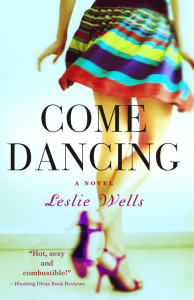
Today’s guest post is by author Leslie Wells.
I’ve been on both sides of the publishing desk—as an acquiring executive editor for several decades, and as an author. The experience has provided insights that I wouldn’t have had otherwise, and made me more sympathetic to the nerve-wracking process of trying to get your book published.
First, let’s look at the editor’s side. An editor’s career hinges on acquisitions. If she doesn’t acquire eight to ten titles per year, then her job is on the line. So an editor is constantly trying to buy books; but that’s not easy as it sounds. Before the weekly meeting, you have to get at least one other editor to read—and like—the manuscript you’re trying to acquire. Then you have to pitch it to an overworked bunch of colleagues who are also trying to fill limited slots on the next list. Most of all, you have to convince your boss, the editor-in-chief—who may or may not have had time to look over your project in the three hours he spent cramming the night before—that it has merit.
If you pass “Go”, the next hurdle is the acquisitions meeting. There are pro formas to fill out: the profit and loss statements that project how many units the book will sell in all formats over a period of time, and which the sales and marketing directors have to sign off on. At times these P&Ls require wild leaps of imagination.
Books are often dead on arrival at the acquisitions meeting, for the following reasons:
- The author doesn’t have a platform (an internet following, TV show, speaking gigs).
- The book reminds someone of a book that came out last year, that didn’t work.
- The sales director had a bad commute.
- The marketing director doesn’t get along with the sales director—so any project he likes, she loathes; and vice versa.
If the stars align and the book isn’t shot down, you are then allowed to plug the new (vastly reduced) projected sales figures into your pro forma, and get the new (vastly reduced) advance amount approved. Finally you’re ready: a $35,000 offer is burning a hole in your pocket.
You take a deep breath and call the agent. Who tells you that the book was pre-empted for six figures, two hours ago.
All this is to explain why, as an author, it can be so hard to get your book published. It was extremely difficult even ten years ago, and is even more so now. So if your carefully revised, lyrically titled, wonderfully imagined novel doesn’t sell, please don’t blame the editor. She may have loved your book, but she probably wasn’t allowed to acquire it.
However, this doesn’t mean it’s the end of the road for you as an author. I’ve experienced being published from both sides too: by a traditional publishing house, and now as a self-publisher. I’m going to describe each experience.
My Traditional Publishing Versus My Self-Publishing Experience
My first novel, The Curing Season, was pre-empted by Amy Einhorn (who went on to publish The Help). Amy’s editing was insightful and thoughtful. There wasn’t a suggestion that wasn’t careful and intelligent; I loved the whole process, and felt very lucky. The art director came up with a beautiful, appropriate cover and the publisher sent me on an eight-city tour (back in the day when authors got sent on tours). The book came out during a time when newspapers and magazines were either killing or drastically reducing book coverage; since social media hadn’t happened yet in the early 2000s, it was difficult to garner much attention. The book did receive some very nice reviews, and overall it was a very positive experience.
For my new novel, Come Dancing, I thought it would be interesting to take a different approach. So many of my author friends are choosing to self-publish that after checking out traditional publishing options, I decided to give it a whirl. The process has been exciting, exhausting, and empowering. First, I got the manuscript in the very best shape I could, which took two years. Next I hired a freelance editor to edit the first draft, and later on, a second editor for the third draft. The revision process took place over a year and a half, then I asked a few friends to read the manuscript and comment. Once again, I revised accordingly. When I couldn’t bear to read it one more time, finally I was done.
Now for the fun part: I chose a designer for my cover (the incredibly talented Laura Klynstra, a former colleague), and she came up with an eye-catching jacket.
Laura also did the interior design, and let me choose from a selection of typefaces and chapter head ornaments. I went to several online reviewers (whom I did not know) to ask if they would be able to provide early quotes, and two generous people gave me nice blurbs. Then I wrote my own jacket copy. I figured out how to upload the book online (with help from my teenager). And once it was up, I e-mailed every single person I knew and asked them to buy it.
Next I set up a Goodreads giveaway, and I paid for a few inexpensive ads on websites that promote e-books. The most difficult thing for me was figuring out the features of the various retail and promotional websites, since I’m not tech literate.
To my surprise, one week after it was published, Come Dancing hit #13 on Amazon’s Hot New Releases list for Fiction/Humor and made the Amazon Best Seller list. It also hit #1 in the Kindle Store for Romantic Comedy.
It’s early days yet—my book has only been out for two weeks at the time of this writing—but so far, the experience has been amazing. Most authors want a shot at being published by a traditional publisher, and I certainly understand that impulse. But if that doesn’t happen for you, going the indie route can be extremely satisfying.
Leslie Wells left her small Southern town in 1979 for graduate school in New York City. After receiving her Master’s in English Lit, she got her first job in book publishing. She has edited 48 New York Times bestsellers in her over thirty-year career, including thirteen number one New York Times bestsellers. Leslie has worked with numerous internationally known authors, musicians, actors, actresses, television and radio personalities, athletes, and coaches. Leslie blogs about writing tips, New York City, rock and roll, and the 1980s.

Congrats to Leslie for her bravery and success! It’s heartening to hear of an editor who hired two other editors to get her book in shape. I wish more self-pubbed authors would do that.
Me too, and this is coming from a self-pubbed author.
I’m amazed to hear she’s seen so much success in just two weeks, though. Normally it takes a year or more to see any kind of return on investment. I get the feeling there’s an aspect to this meteoric rise that we’re not seeing.
Congrats to her but she’s hardly the typical self-pub, and I’m betting that she reached out to a lot of folks that the average debut self-pub can’t access. Success stories like this one are charming but do little to instruct the 99.9 percent of self-pubs out there.
You are the most lifelike Turing program I have yet encountered. Kudos to your creators.
Truth is simplicity personified.
This comment makes absolutely no sense.
It makes more sense when you follow multiple publishing blogs and see the pattern of Smithbot appearing, calling everyone ignorant and/or stupid and making assertions with no citations or data, and then vanishing again. That’s it. That’s all it does. Deborah Smith the author is a real person, to the best of my knowledge and belief, but Deborah Smith Author the internet commenter is a Turing program, in my opinion.
It’s obviously an AI, but it’s a pretty well-fleshed-out one with a fairly deep context base. It’s also really good at discriminating between pro-traditional-publishing comments and pro-independent-publishing comments. Hence my compliment. That’s some pretty slick programming. If tradpub had used that kind of wizardry on Bookish, it might not be in this mess.
That would be all her contacts in the business that she has. She’s not the other 99.99% who are shopping their book to book blogs that may or may not be her true reading audience; she’s not self promoting on every network available, eating into her writing/family/dayjob time; she’s not wondering where else she can risk alienation by requesting a review or offering up her latest guest blog post. It’s a zillion times tougher for the average self published author than the experience she puts forth here.
I can see why she’s succeeding. She has something of an original fanbase, the cover is gorgeous, and $1.99 for a new novel on the Kindle? That’s a bargain! Well done.
Free is an even better bargain.
http://amzn.com/B00BJCLMFU
I also have a fantastic cover and an original fanbase, and I’m not doing anywhere near this good. She has a network, and that’s the magic.
Congrats, Leslie! And LOVE the description of the acquisitions process…
Congrats, Leslie. I enjoyed the description of the acquisitions process and am very impressed by your savvy use of both traditional and indie publishing tools.
Hi Shirley,
Thank you so much for your note! And I wanted to reply with a little more detail, as I see some other posts about whether I was able to use my traditional contacts for the indie process. Actually I found that the two worlds are very separate; the indie process is entirely different from trad publishing (in which an agent sells your book, and the publisher pretty much does everything for you). I didn’t know anything about independent publishing when I started the process, and I would like to pass along some specific steps that I took.
First and most importantly, I hired two separate professional editors to edit different drafts of my novel. I knew them, but I paid the normal rate for their services and I asked them to be brutally honest (and they were). I took their advice, and rewrote my book numerous times. Then I asked a few other trusted friends to comment (as one would with a writing group), and I took much of their criticism to heart, as well. I spent five years revising Come Dancing (not to suggest that it should always take someone that long to write a book, but I work full-time and had to do my own writing in the wee hours of the morning and on weekends).
When I decided to self-publish, I was starting from zero, so I ordered four different guides (all under $10) and read up on the process. I found these guides to be very helpful: Self-Publish Your Novel by Robert Kroese; Success Selling ebooks by Victorina Lieske; Let’s Get Visible by David Gaughran; and The Naked Truth about Self-Publishing by The Indie Voice. I also read a number of blogs, including Jane Friedman’s blog, for information.
Leslie: Thanks so much for adding more detail. Having been on both sides of the desk myself, it requires a lot of work and careful research to indie publish thoughtfully, regardless of who you might know.
An inspiring story – we’ll share with our tribe!
[…] to the rest at Jane Friedman and thanks to SFR for the […]
Congratulations, Leslie, and welcome to the fold. 😉
[…] Leslie Wells compares her experiences in traditional publishing and self-publishing from the view of being both an author and an editor. […]
[…] oder doch lieber Selfpublishing? Leslie Wells hat beides probiert und schreibt im Artikel Both Sides Now: A New York Editor and Author Goes Indie von ihren […]